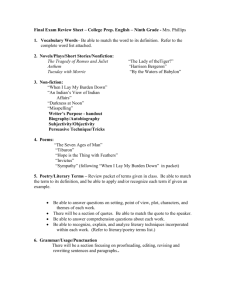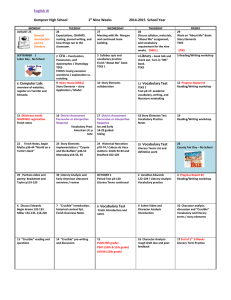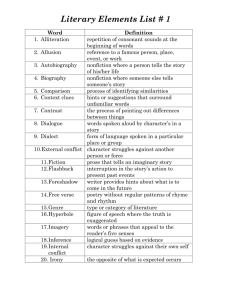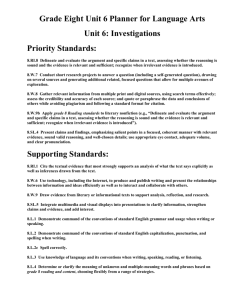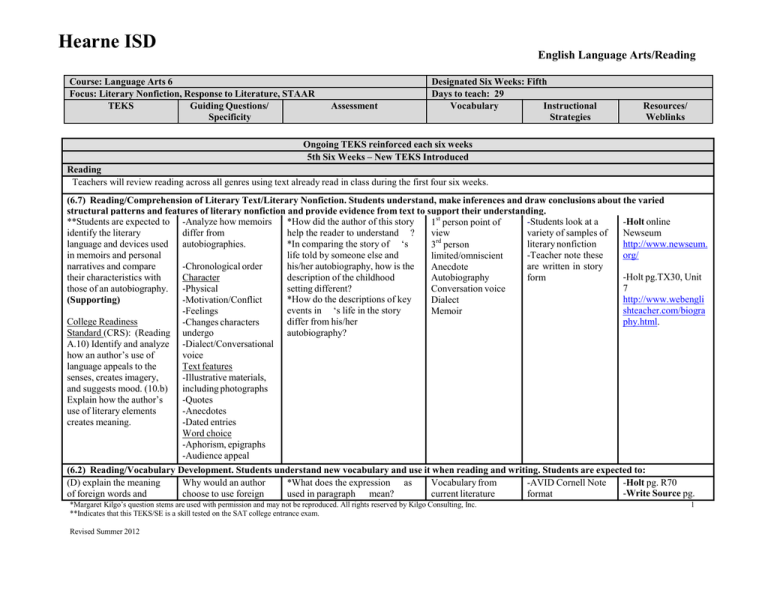
Hearne ISD
English Language Arts/Reading
Course: Language Arts 6
Focus: Literary Nonfiction, Response to Literature, STAAR
TEKS
Guiding Questions/
Specificity
Assessment
Designated Six Weeks: Fifth
Days to teach: 29
Vocabulary
Instructional
Strategies
Resources/
Weblinks
Ongoing TEKS reinforced each six weeks
5th Six Weeks – New TEKS Introduced
Reading
Teachers will review reading across all genres using text already read in class during the first four six weeks.
(6.7) Reading/Comprehension of Literary Text/Literary Nonfiction. Students understand, make inferences and draw conclusions about the varied
structural patterns and features of literary nonfiction and provide evidence from text to support their understanding.
**Students are expected to -Analyze how memoirs
*How did the author of this story
-Students look at a
-Holt online
1st person point of
identify the literary
differ from
help the reader to understand ?
variety of samples of
Newseum
view
language and devices used autobiographies.
*In comparing the story of ‘s
literary nonfiction
http://www.newseum.
3rd person
in memoirs and personal
life told by someone else and
-Teacher note these
org/
limited/omniscient
narratives and compare
-Chronological order
his/her autobiography, how is the
are written in story
Anecdote
-Holt pg.TX30, Unit
their characteristics with
Character
description of the childhood
form
Autobiography
7
those of an autobiography. -Physical
setting different?
Conversation voice
*How do the descriptions of key
http://www.webengli
-Motivation/Conflict
(Supporting)
Dialect
events in ‘s life in the story
shteacher.com/biogra
-Feelings
Memoir
College Readiness
phy.html.
differ from his/her
-Changes characters
Standard (CRS): (Reading undergo
autobiography?
A.10) Identify and analyze -Dialect/Conversational
how an author’s use of
voice
language appeals to the
Text features
senses, creates imagery,
-Illustrative materials,
and suggests mood. (10.b)
including photographs
Explain how the author’s
-Quotes
use of literary elements
-Anecdotes
creates meaning.
-Dated entries
Word choice
-Aphorism, epigraphs
-Audience appeal
(6.2) Reading/Vocabulary Development. Students understand new vocabulary and use it when reading and writing. Students are expected to:
-Holt pg. R70
(D) explain the meaning
Why would an author
*What does the expression as
Vocabulary from
-AVID Cornell Note
-Write Source pg.
of foreign words and
choose to use foreign
used in paragraph mean?
current literature
format
*Margaret Kilgo’s question stems are used with permission and may not be reproduced. All rights reserved by Kilgo Consulting, Inc.
**Indicates that this TEKS/SE is a skill tested on the SAT college entrance exam.
Revised Summer 2012
1
Hearne ISD
English Language Arts/Reading
Course: Language Arts 6
Focus: Literary Nonfiction, Response to Literature, STAAR
TEKS
Guiding Questions/
Specificity
phrases commonly used in
written English (e.g.,
RSVP, que sera sera);
phrase rather than the
English equivalent?
Assessment
*The phrase
means -
used in paragraph
Designated Six Weeks: Fifth
Days to teach: 29
Vocabulary
Instructional
Strategies
study
-Journal questions
-Word stems
Resources/
Weblinks
648.4
http://www.infopleas
e.com/ipa/A0001619.
html
(CRS): (Reading B.2)
Apply knowledge of roots
http://www.dailywriti
and affixes to infer the
ngtips.com/6-foreignmeanings of new words.
expressions-you(2.a) Identify word
should-know/
meanings based on their
Greek or Latin roots.
Oral and Written Conventions
(6.19) Oral and Written Conventions/Conventions. Students understand the function of and use the conventions of academic language when speaking and
writing. Students will continue to apply earlier standards with greater complexity. Students are expected to:
-Interactive notebook Texas Write Source
**(B) differentiate
When is active voice
Students use and stay with
Active voice
-Show examples
Holt pg. R57
between the active and
more appropriate than
appropriate voice throughout
Passive voice
using literary and
passive voice and know
passive voice?
piece of writing
information text
how to use them both
-Teacher model and use
guided practice with
students
Listening and Speaking
(6.27) Listening and Speaking/Speaking. Students speak clearly and to the point, using the conventions of language. Students will continue to apply earlier
standards with greater complexity.
*Margaret Kilgo’s question stems are used with permission and may not be reproduced. All rights reserved by Kilgo Consulting, Inc.
**Indicates that this TEKS/SE is a skill tested on the SAT college entrance exam.
Revised Summer 2012
2
Hearne ISD
English Language Arts/Reading
Course: Language Arts 6
Focus: Literary Nonfiction, Response to Literature, STAAR
TEKS
Guiding Questions/
Specificity
Students are expected to
give an organized
presentation with a
specific point of view,
employing eye contact,
speaking rate, volume,
enunciation, natural
gestures, and conventions
of language to
communicate ideas
effectively.
Why is it necessary for
students to
communicate ideas
effectively?
Assessment
Rubric based on SE’s
Designated Six Weeks: Fifth
Days to teach: 29
Vocabulary
Instructional
Strategies
Enunciation
Eye contact
Gestures
Point of view
Speaking rate
Volume
-Teacher modeling –
students grade
teacher
Resources/
Weblinks
-Rubric:
http://www.rubrics4te
achers.com/language
arts.php.
-Holt pg. 180-181,
R78
-Write Source pg.
435-451
(CRS): (Speaking A.1)
Understand how style and
content of spoken
language varies in
different contexts and
influences the listener’s
understanding. (1. b)
When speaking, observe
audience reaction and
adjust presentation (e.g.,
pace, tone, vocabulary,
body language) to suit the
audience.
*Margaret Kilgo’s question stems are used with permission and may not be reproduced. All rights reserved by Kilgo Consulting, Inc.
**Indicates that this TEKS/SE is a skill tested on the SAT college entrance exam.
Revised Summer 2012
3


